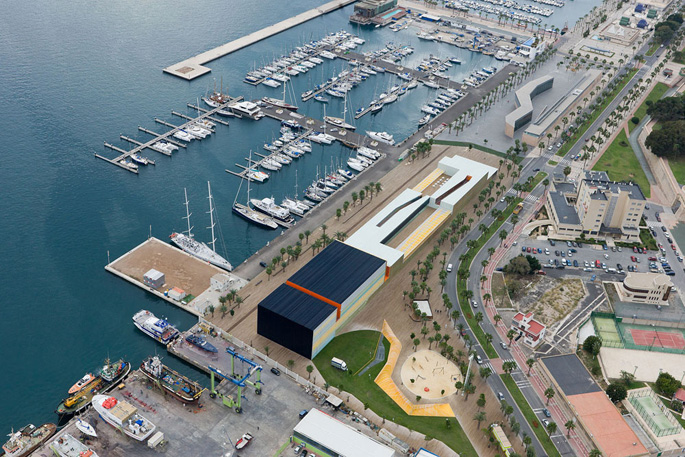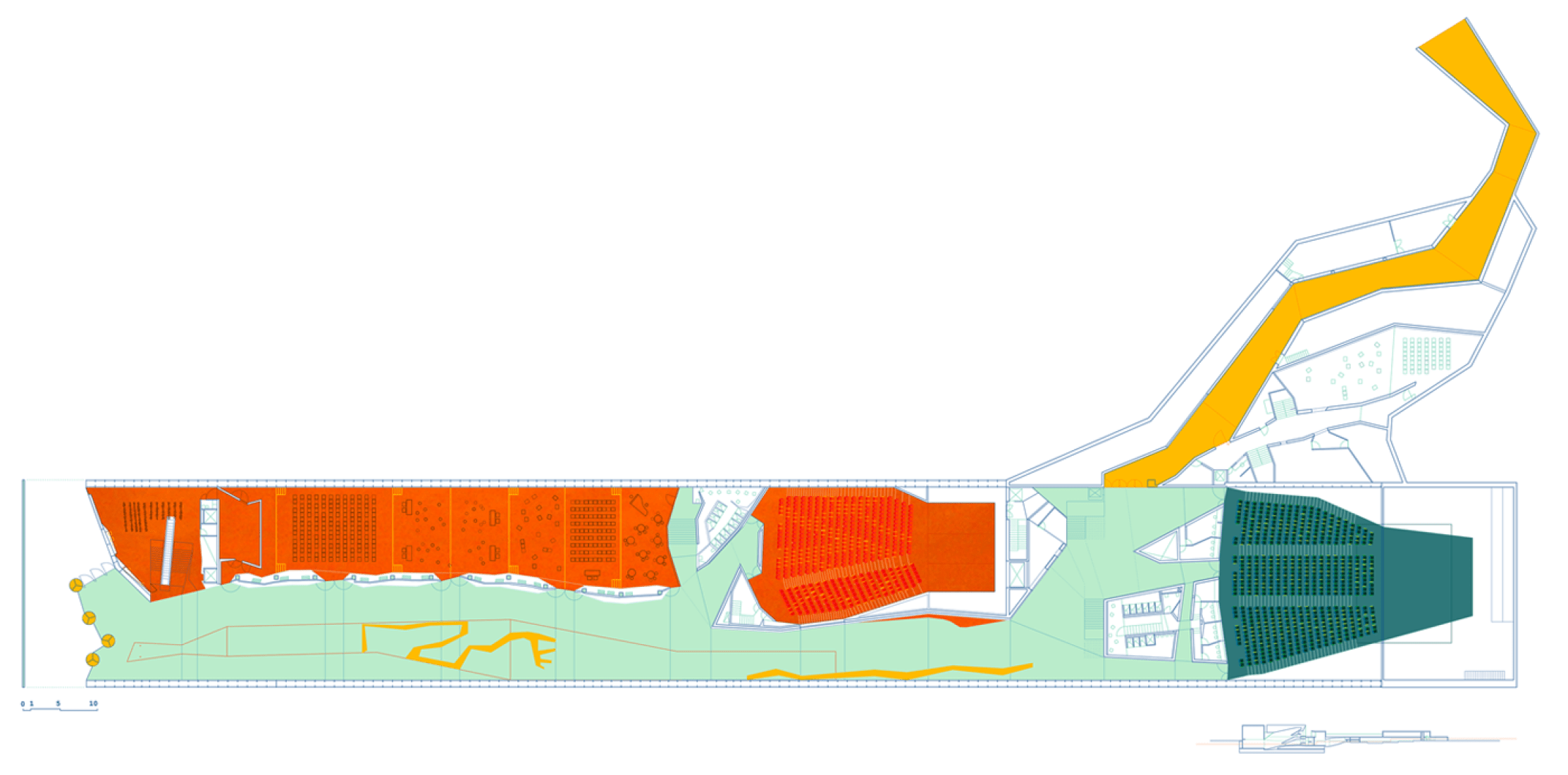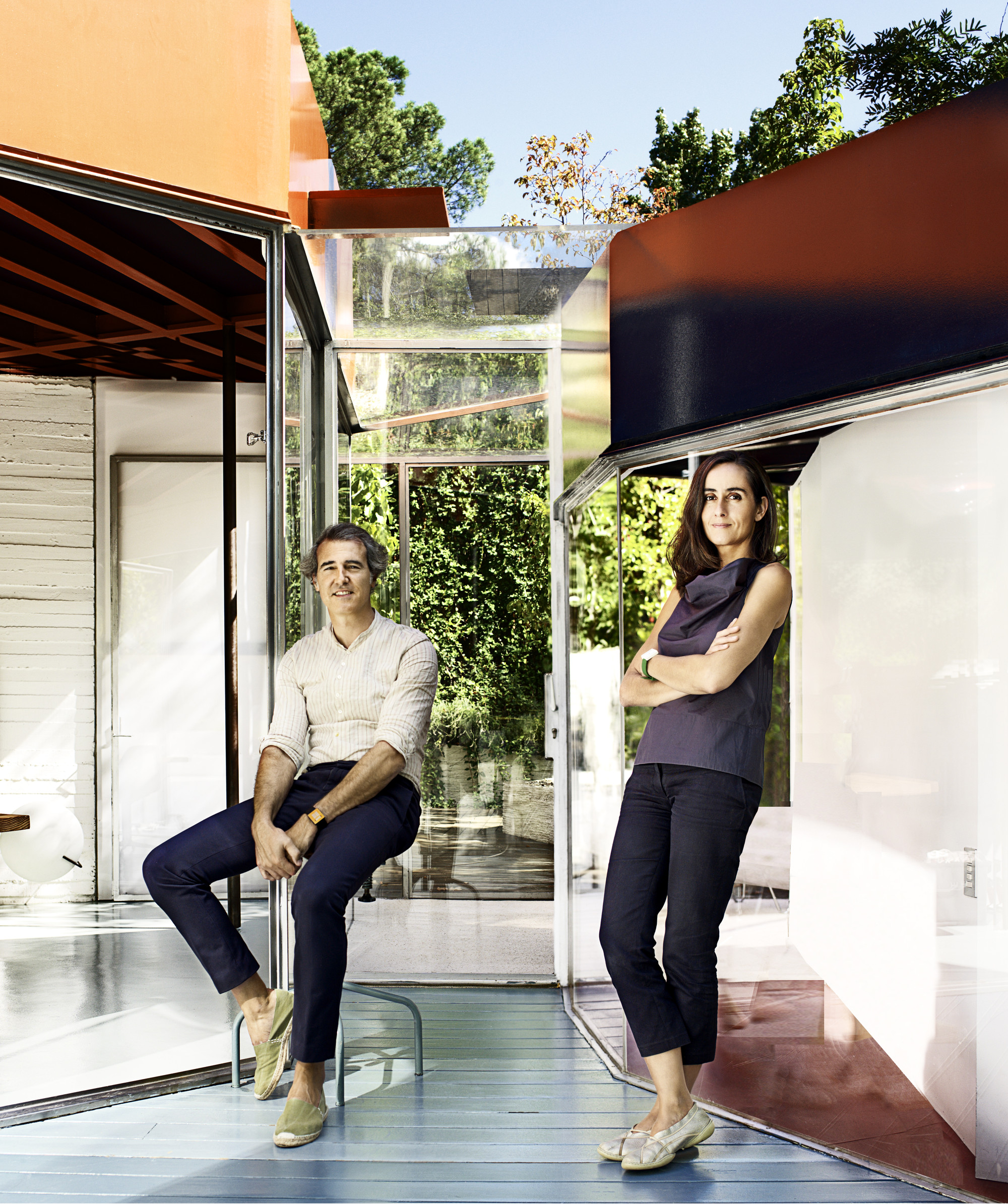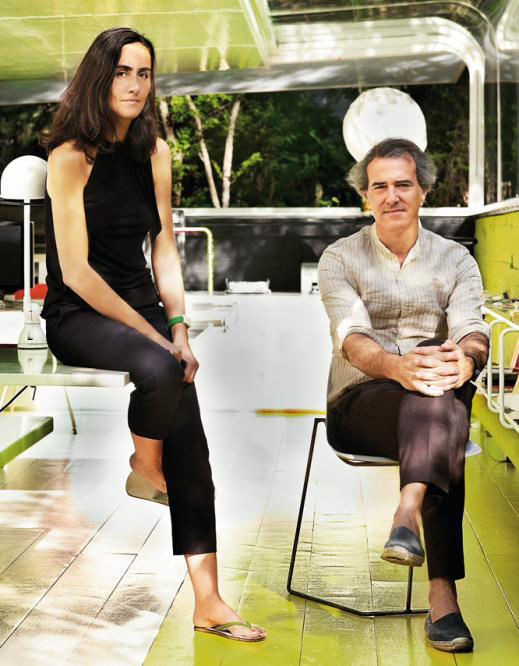The "B" is an Auditorium and Convention Center that retrieves a friendly relationship of the city with the port. Its image geometrically very clear, simple and developed most of its program under the level of access is certainly a great piece and clearly contemporary in both colors and materials. Experiments on other projects such reflective materials, plastics, has allowed them to give a clear answer. The colors speak about illusion, desire to experience an auditorium and conference center, and no small feat, given the current economic situation. Generate want to visit architecture and programs that are held there as smart as the ease and skill with which the materials have been used. It is an attraction for a city that seems to smile and it makes you want to go. Hat tip!

Aerial view. Cartagena
To be in a borderline:
"... in the hot sun (they feed on the sun), in the shade (they feed on the shade), or in the borderline between sun and shade"
H. Michaux
El "B" is this long construction, a body, that feeds on the heritage -the continuity- of a site's treatment: THE Cartagena harbour, which is nothing but a harbour in Cartagena, borderline of the city from the sea. Everything here belongs to it, belongs to the port, any port we should say: the immaculate straightness of the pier edge (straight), the invariably calm sea (flat), the artificially horizontal plane of the dock (flat), the sky as the variable background for this plane (plane on a plane?), all based on an artifice to represent the simplest -and by virtue of its simplicity, the most natural, the most immensely artificial- plane that equates to the most natural.
The Alfonso XII dock is 1,000 metres long, exactly a kilometre, where we can assume that we are at the end. A 20 metre wide strip runs the full length, parallel to the edge, which is respected by the buildings. A very pleasant walk can be designed for the city along this strip, a daily procession following the immutable edge. In fact, this promenade is what we encourage; it is what we insert in the building, in a dimensional continuum that seems to dig out an artificial beach, but is actually a continuity of history, because the old El Batel beach was right here, on this very spot. The harbour is artificial, not the beach.
This reclaimed beach-ramp gradually submerges us below the waterline, with the pier's horizontal line as a constant reference. At this point we cease to belong to the outside world and start to belong to ourselves, ourselves in movement, ourselves strolling, working on the 210 metre scale reserved site for ourselves. We have worked on the contrast with the outer facade produced by the cut at ground level, and we continue to make use of the dictatorship of the dock, but precisely in opposition to it.
We refuse include the harbour's beautiful orthogonal monotony; we exclude the hardness of the port from the interior, and instead, we seek something that is completely the opposite: translucent, delicate, light, aquatic; something that has to do with what Luigi Nono defined as "a space for water music".
Each component and detail of this project is another project in itself, but, as each project, acting in obedience to its surroundings, all belong to both a whole, not sought, but deduced, which is what shapes the character of El "B".
All the material, both aluminium and plastic, is manufactured from a single extruded section, varied in placement and colour to give the appearance of multiple pieces. These pieces are all set parallel to the pier edge to underscore the idea of horizontality and achieve an even longer rectangle than it already is, in this case extruded like a “churro” (wrinkled doughnut), only on its immediate scale: overall, it seems to be the result of an accumulation of different components, stacked neatly on the pier. The memory of a former use.
Outwardly and also inwardly, this is an extremely false complex, one set as the antagonist of the other, like people who seem to be very quiet but are actually paralyzed by the continuous movement of their central nervous system. Their antagonism is clearly evident in the coexistence of the upper and the lower floors, a perfect example of anacoluthon: there is no agreement between them. Their only connection is that both thrive on the harbour, because, we insist, the entire project thrives on the idea and the memory of a harbour; what happens here now and what used to happen here.
Text by SelgasCano.

Aerial view project.
CREDITS.-
Location: Paseo de Alfonso XII s/n. 30202 - Cartagena, Spain.
Client: Cartagena Council.
Architects: SelgasCano, arquitectos (José Selgas, Lucía Cano).
Design Team: Lara Resco, Carlos Chacón, José de Villar, José Jaraiz, Lorena del Río, Blas Antón, Miguel San Millán, Julián Fernandez, Beatriz Quintana, Jaehoon Yook, Jeongwoo Choi, Laura Culiañez, Bárbara Bardín. Interior Design, Architect of Record: SelgasCano, arquitectos. Structural Engineering: FHECOR Mechanical/Electrical/Plumbing Engineering: JG. Acoustic Engineering: ARAU ACUSTICA. Textile Engineering: LASTRA Y ZORRILLA. Model: Gilberto Ruiz Lopes. Architectural Assistants: Antonio Mármol, Joaquín Cárceles, Rául Jiménez
Site area: 5.628 m2
Total built area: 18.500 m2
Design phase: 2002-2004
Construction: 2006—11/2011
Budget: 34.5 million €
General Contractors: Dragados, Intersa. Plastic Manufacturers: Polimertecnic, Sabic. Auditorium Seating: Figueras. Floor Manufacturer: Prialpas. Lighting Manufacturers: Idealux, Talleres Zamora. Wall Manufacturer: ATA Aislamientos Tecnicos Agroalimentarios.
Brief about project: Hall a 1420 seats, Hall b 470 seats, 10 Conference Rooms 1000 seats, Exhibition zone 850m2, Restaurant zone 560 m2, Outdoor terraces 1400m2, Foyer-Distributor 1500m2, Dressing Rooms 120 seats, Rehearsal room 120m2, Hall "a" stage 500m2, Hall "b" stage 200m2.


















































